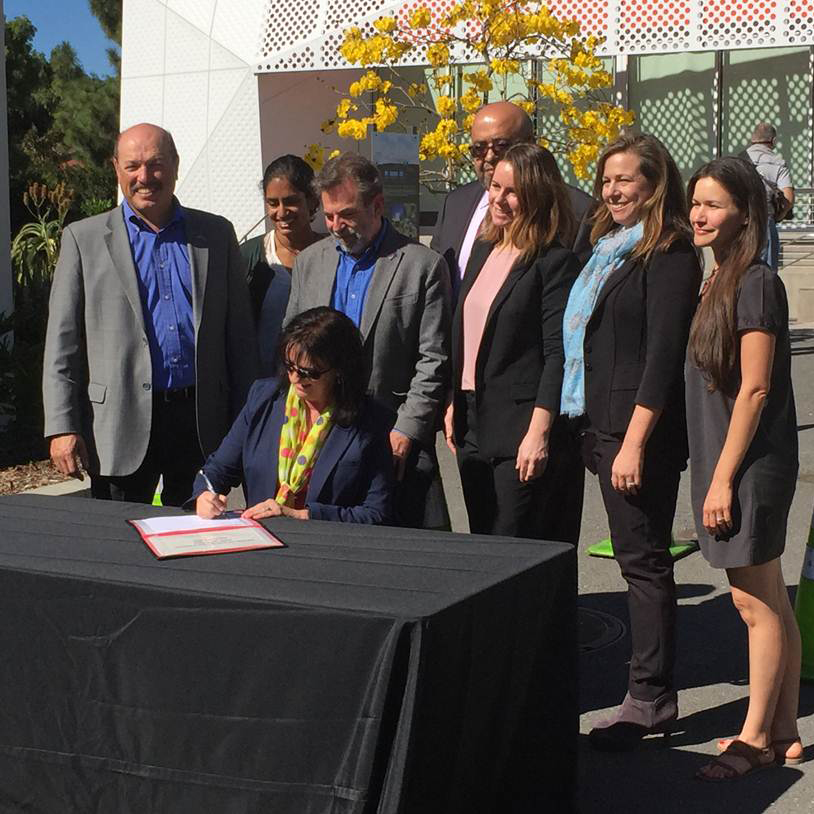Matrix 2.0: New Rules Out for Water Recycling
Feb. 16, 2016 — Matthew King, Heal the Bay’s communications director, peers into the dirty laundry at Loews Hotel. When it comes to a more sustainable L.A., he likes what he sees.
“What’s good for the environment is good for business.”
It’s a saying I often throw around the office when crafting talking points for various Heal the Bay initiatives. But it’s great to see those words put into action locally, as I did Tuesday morning during a tour of the Loews Santa Monica Beach Hotel.
I joined a few journalists on a junket arranged by the city of Santa Monica to highlight innovative stormwater capture and water recycling projects in our town. We stopped at Loews because the hotel has implemented an effective program to reduce its water use via recycling.
As one of the bigger commercial water users in Santa Monica, Loews worked with city officials to conduct an audit of how the hotel used water each year and how the business could manage it more efficiently. Guests are doing a better job of reusing towels and not demanding new sheets each morning, but laundry still remains the biggest user of water on the property, according to the hotel’s spokeswoman, Rachel Kaye.
So last year the hotel installed an onsite, closed-loop system to recycle 70% of the water used each day for laundry. Using ultraviolet technology, the system disinfects laundry wastewater during the final rinse cycle. That cleansed water is then pumped back to start the wash cycle of subsequent loads. Because that water is already heated from the previous cycle, the system requires far less energy than conventional washing.
In all, Loews has reduced its overall annual water use by 22% by installing the system – some 4.3 million gallons a year. They also reduced their energy consumption related to laundry by more than 50%.
Buoyed by that success, Loews is in the middle of installing low-flow showerheads, toilets and faucets in its 347 guest rooms, with a goal of reducing in-room water use by more than 40%, according to Kaye. She says surveys of guests who have stayed in the rooms that have already been converted don’t indicate any concerns with the changes.
Economic forces drive change in our society, so it’s encouraging to see Loews saving on energy and water costs. The switch to recycled water and low-flow infrastructure will surely benefit their bottom line and shareholders, which will serve as an incentive for further changes. But most important (to us), the switch will benefit the local environment. Businesses like Loews have the scale and visibility to hopefully nudge other companies sitting on the sustainability fence.
Before Loews, the city’s Neal Shapiro took us to a few other stops. The operations and maintenance center for the new Metro light-rail network near Centinela Boulevard has installed a 400,000 gallon cistern that will capture stormwater runoff from local stormdrains. The water will be reused for irrigation of the grounds and to clean equipment at the site. At our next stop, I learned that the city of Santa Monica has also received a $1 million grant to tap into the city of L.A.’s massive stormwater collection cistern underneath Penmar Park, which is located near the border of Santa Monica and Venice. A pipeline will carry reclaimed water to irrigate Santa Monica’s Marine Park, which is located less than a mile away.
The media tour, capably organized by the city’s Andrew Basmajian and PR whiz Julie Du Brow, served as context for today’s unveiling of a multiagency-shaped roadmap for scaling up alternative water supplies in L.A. County. Heal the Bay and partner NGOs helped announce the roadmap – dubbed Matrix 2.0 – at a ceremony today at the Pico Library in Santa Monica.
Matrix 2.0 provides legal and practical guidelines on how individuals, businesses, cities and other entities can use rainwater, graywater, stormwater and so-called blackwater to gain better water self-sufficiency.
The rules will help simplify the regulatory patchwork involved in trying to get recycling and capture systems installed and approved in our region.
The document took months of work by the Los Angeles County Department of Public Health, City of Los Angeles Bureau of Sanitation and the City of Santa Monica Office of Sustainability and the Environment. The backbone of L.A’s environmental movement – TreePeople, the Natural Resources Defense Council and Heal the Bay – also helped shape the final product. Kudos to all! You can see the new guidelines here.
Hopefully these guidelines will spur companies and municipalities to follow in the footsteps of Loews and the city of Santa Monica. With the L.A. region still importing 80% of its water, it’s time to get shovels in the dirt – not just study proposals and prepare PowerPoints.
 |  | |
| Terri Williams, L.A. County’s Acting Director of Environmental Health, signs the Matrix 2.0 guidelines. HtB’s Rita Kampalath (2nd from left) looks on. | Loews Santa Monice Beach Hotel’s Rachel Kaye discusses the benefits of its water recycling system with members of the local media. |


